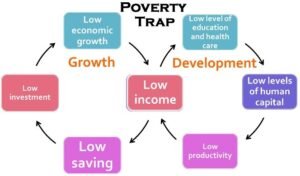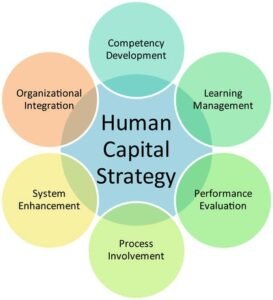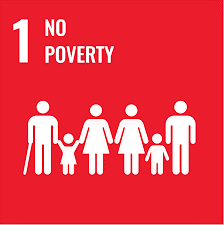POVERTY AND DEVELOPMENTAL ISSUES
“Poverty is the condition where an individual or group lacks the basic resources and income to meet their essential needs for a minimum standard of living.”
- World Bank
Poverty is a global challenge affecting billions of people. It is manifested as deprivation of basic needs such as food, clean water, shelter, education and healthcare which deprives a person of dignity, minimum standard of living and well-being.
| SDG 1 – No Poverty |
|
It seeks to reduce the proportion of people living in poverty by providing social protection and economic opportunities. |
In this chapter, we will study Poverty and its measurement, the consequences of poverty, challenges faced in the eradication of poverty and the way forward for making an inclusive and prosperous society by eradicating poverty.
What is Poverty?
- What is Poverty?
- Social Causes of Deprivation
- Social exclusion:
- Vulnerability:
- Types of Poverty
- Income-Based Poverty
- Geographical-Based Poverty
- Circumstantial-Based Poverty
- Poverty Line
- Types of Poverty Lines
- Head Count Ratio (HCR)
- Why is Poverty measurement in terms of Income only criticized?
- Multidimensional Poverty Index (MPI)
- Theories of Poverty
- Vicious Cycle Theory
- Human Capital Theory
- Dependency Theory
- Related FAQs of POVERTY AND DEVELOPMENTAL ISSUES
Poverty is an economic condition in which people lack enough financial resources to live a decent standard of life.
At its core, poverty is closely tied to income, because it is the low income that limits individuals’ ability to afford essentials like food, shelter, education and healthcare. When income falls below a certain level, people face economic deprivation which creates a deprivation of basic needs.
However, income alone does not fully capture the scope of deprivation and poverty. Some other factors like lack of access to education, healthcare and essential services, poor living conditions and social exclusion. These elements provide a more comprehensive understanding of poverty, which is critical for survival, dignity and social participation.
- Illiteracy level,
- lack of general resistance due to malnutrition,
- lack of access to healthcare,
- lack of job opportunities,
- lack of access to safe drinking water & sanitation.
Poverty as Deprivation
Poverty as deprivation goes beyond income levels, focusing on the lack of access to essential resources like food, shelter, healthcare and education. It highlights how poverty is not just about insufficient money but also about being excluded from opportunities that enable a decent standard of living.
This approach emphasizes the multidimensional nature of poverty, considering factors like social exclusion, poor living conditions, and systemic barriers. It provides a broader understanding of poverty, encouraging interventions that address inequality, access to service, and social justice, rather than focusing solely on income redistribution.
Social Causes of Deprivation
| Deprivation refers to the condition where individuals or groups lack the essential resources or capabilities needed to live a minimally acceptable standard of life. |
Poverty is essentially the inability of a person or a community to maintain a basic level of consumption. This is not only caused by economic conditions but also due to social inclusion & vulnerability:
Social exclusion:
Social Exclusion is the inability to access the prevailing social system and its rights and Privileges.
- Poor having to live only in a poor surrounding with other poor people, excluded from enjoying the social equality(of facilities, benefits and opportunities) of better-off people in better surroundings.
- It can both be a cause and consequence of poverty. For example, the Caste system.
Vulnerability:
It is a measure that describes the greater probability of certain communities or individuals becoming or remaining poor in the coming years. Determined by the options available for finding an alternative living in terms of education, health and job opportunities.
They are at greater risk during natural disasters, terrorism etc. Thus their social and economic inability to handle risk is vulnerability. We have understood this term in greater detail in our disaster Management book.
| The Capability Approach (Amartya Sen) |
|
Types of Poverty
Poverty is a multifaceted issue that goes beyond just a lack of income. It is often classified into different types to better understand its various dimensions and address the specific needs of affected populations. These classifications help policymakers and organizations create targeted interventions for reducing poverty and its associated challenges.
Income-Based Poverty
- Absolute Poverty: Lack of sufficient resources to meet basic human needs like food, shelter, clean water and healthcare. For example, A family living below the poverty line (e.g. living on less than $2.15 a day).
- Relative Poverty: Poverty is defined in relation to others in society. Even though basic needs are met, individuals are unable to fully participate in society due to economic inequality. For example, A person in an affluent society who can afford basic needs but cannot afford social activities or education.
Geographical-Based Poverty
- Rural Poverty: Poverty in rural areas due to limited access to infrastructure, healthcare, education, and job opportunities. For example, A farmer in a remote area without access to modern farming techniques, healthcare or markets.
- Urban Poverty: Poverty in urban areas due to overcrowding, high living costs, unemployment and lack of affordable housing. For example, Individuals living in slums in urban cities like Mumbai, lack sanitation and job opportunities.
Circumstantial-Based Poverty
- Situational Poverty: Temporary poverty caused by specific circumstances like job loss, natural disasters, or personal crises. For example, A person who loses their job due to an economic downturn and faces temporary financial hardship.
- Chronic Poverty: Long-term poverty due to systemic barriers, such as lack of access to education and healthcare, leading to persistent hardship. For example, Families trapped in poverty for generations, unable to break the cycle due to limited opportunities.
Each type of poverty reflects a different category of deprivation, and understanding these categories allows for a more nuanced approach to addressing poverty through targeted policies and interventions.
After discussing the types of poverty, measuring poverty is essential to understand its extent and identify the most vulnerable populations. It allows policymakers to allocate resources effectively, prioritize interventions and track progress in poverty alleviation efforts.
Poverty Line
The poverty line is the minimum level of income or consumption required to meet basic needs such as food, clothing, shelter and essential services like healthcare and education.
Types of Poverty Lines
- Absolute Poverty Line: A fixed threshold based on the cost of basic necessities, often used in developing countries. For example, The World Bank’s international poverty line was recently updated to $2.15 per day (as of 2022).
- Relative Poverty Line: Defined in relation to the income distribution of a specific population, often set at a percentage (e.g., 50%) of median household income.
The poverty line in terms of income is a threshold used to determine who is considered poor based on their income level. Those earning below this threshold are classified as living in poverty, while those earning above it are deemed non-poor. This measure is often used for statistical purposes and to design poverty alleviation policies.

Head Count Ratio (HCR)
The Head Count Ratio (HCR) is a commonly used indicator in poverty measurement, which quantifies the percentage of a population that is living below a specified poverty line, reflecting the incidence of poverty.
Significance of HCR
- It provides a basic measure of the extent of poverty in a population.
- It is often used to track poverty reduction progress over time.
- While it helps identify the proportion of poor people.
Why is Poverty measurement in terms of Income only criticized?
Poverty measurement has long been a subject of debate, with various critiques highlighting its limitations and flaws. Traditional methods, often relying on income thresholds, fail to capture the full complexity of poverty, overlooking factors such as regional disparities, non-income deprivations and the broader social context. So it is criticized based on the following points:
- Narrow Focus: Income-based measures only capture financial resources and ignore other essential aspects of poverty, such as access to healthcare, education and basic services.
- Excludes Non-Market Resources: Non-market factors like community support or government assistance programs aren’t reflected in income-based measures, even though they can help alleviate poverty.
- Doesn’t Reflect Quality of Life: People with similar incomes can have vastly different living standards depending on factors like cost of living, health or family circumstances, which income measures fail to capture.
- Ignores Inequality: Income measures don’t account for income inequality within a society, which means someone just above the poverty line may not have the same opportunities or quality of life as wealthier individuals.
- Overlooks Multidimensional Aspects: Poverty is more than just low income; it involves social exclusion, lack of opportunities and vulnerability, which aren’t captured by income alone.
- Underestimates Long-Term or Cyclical Poverty: Income measures focus on current income levels, failing to recognize long-term poverty or individuals who are temporarily above the poverty line but still face ongoing financial insecurity.
The Multidimensional Poverty Index (MPI) is preferred over income-based measures because it provides a more comprehensive view of poverty. While income measures focus only on financial resources, the MPI includes factors like education, health, and living standards, which offer a better understanding of deprivation.
Multidimensional Poverty Index (MPI)
The Multidimensional Poverty Index (MPI) measures this deprivation across three dimensions: health, education and living standards, considering factors like nutrition, schooling, sanitation and access to electricity or clean water.
Individuals are considered MPI-poor if deprived in at least one-third of the indicators. The MPI quantifies deprivation, offering a comprehensive view of poverty beyond income, with higher scores of MPI indicating greater poverty.
The MPI combines the headcount ratio (the percentage of the population that is multidimensionally poor) and the intensity of poverty (the average number of deprivations experienced by the poor) into a single score ranging from 0 to 1.
Theories of Poverty
The different theories of poverty aim to explain the underlying causes and persistence of poverty within societies. These theories explore various factors, including individual behaviours, societal structures, economic systems and cultural norms, that contribute to the marginalization of certain groups.
By studying these theories, we gain insights into why poverty continues to exist despite economic progress and how best to formulate policies for its eradication. The most widely discussed and influential theories to explain poverty are –
Vicious Cycle Theory
 The Vicious Cycle Theory explains that poverty is a self-reinforcing process that becomes harder to escape. People in poverty have limited access to basic resources like education, healthcare and nutrition, which reduces their ability to improve their skills or health. This leads to low-paying jobs and poor living conditions, which perpetuate the cycle.
The Vicious Cycle Theory explains that poverty is a self-reinforcing process that becomes harder to escape. People in poverty have limited access to basic resources like education, healthcare and nutrition, which reduces their ability to improve their skills or health. This leads to low-paying jobs and poor living conditions, which perpetuate the cycle.- For example, A child born into poverty may have limited access to education, which leads to poor job prospects as an adult, perpetuating poverty for themselves and their future children.
- Breaking the cycle requires interventions in education, healthcare, financial support and job opportunities to help individuals improve their situation and escape poverty.
Human Capital Theory
 Human Capital Theory suggests that poverty arises from insufficient investment in education, skills and health. Without proper education or good health, individuals have lower productivity and earning potential, trapping them in poverty.
Human Capital Theory suggests that poverty arises from insufficient investment in education, skills and health. Without proper education or good health, individuals have lower productivity and earning potential, trapping them in poverty.- For example, a person without formal education, skills and proper information may be stuck in low-paying jobs and poor health can further limit their ability to work.
- The solution lies in investing in education, training, and healthcare to improve human capital, enabling individuals to access better opportunities and break free from poverty.
Dependency Theory
- Dependency Theory argues that poverty in developing countries (Some African Countries) is caused by their dependence on wealthier nations. The global economic system exploits poorer countries by extracting resources and cheap labour while offering little in return.
- This keeps developing nations trapped in poverty. For example, a country may export raw materials but see little profit reinvested locally.
- The solution involves promoting economic independence, fair trade and reforms to reduce global inequality and encourage self-sufficiency and industrialization in developing countries.
Cycle of Poverty
The cycle of poverty refers to a self-perpetuating loop where poverty leads to conditions that maintain or worsen poverty across generations. It is difficult to break without external interventions. The cycle consists of several interlinked factors:
- Lack of Education: Poor families often cannot afford quality education, limiting opportunities for better-paying jobs.
Low Income: Without access to good jobs, individuals earn insufficient wages to meet basic needs.
- Poor Health: Limited access to healthcare leads to poor health, reducing productivity and increasing expenses.
- Unemployment or Underemployment: Low education and health prevent access to stable, well-paying jobs.
- Lack of Assets and Savings: Low incomes prevent savings, making it impossible to invest in opportunities or handle financial shocks.
- Social and Economic Inequality: Discrimination or structural barriers keep certain groups disadvantaged.
- Inadequate Living Conditions: Poor housing, sanitation, and nutrition contribute to health and educational deficits.
These factors reinforce each other, creating a persistent poverty trap. Breaking the cycle requires targeted interventions like education, healthcare access, social empowerment and inclusive economic policies.
Related FAQs of POVERTY AND DEVELOPMENTAL ISSUES
The World Bank defines poverty as the lack of income and resources to meet basic needs like food, clean water, shelter, and healthcare. It’s a major barrier to a decent standard of living and human dignity.
Poverty negatively affects education, health, economic mobility, and social inclusion, making it harder for individuals and communities to live fulfilling, dignified lives and contribute to national development.
The MPI measures poverty beyond income, using indicators across health, education, and living standards. A person is MPI-poor if deprived in at least one-third of the indicators, offering a holistic view of poverty.
Poverty can be absolute, relative, rural, urban, situational, or chronic. These categories help in understanding the diverse challenges faced by different populations and formulating targeted policies.
Major theories include the Vicious Cycle Theory, Human Capital Theory, and Dependency Theory. These explain poverty through lack of education and health, systemic global exploitation, and intergenerational traps.

 SDG 1 (No Poverty) aims to eradicate poverty in all forms for all people everywhere, ensuring equal access to basic services and opportunities.
SDG 1 (No Poverty) aims to eradicate poverty in all forms for all people everywhere, ensuring equal access to basic services and opportunities.
![Home Rule Movement (1916-1918): India'S Fight For Self-Governance [Upsc Notes] | Updated November 12, 2025 Home Rule Movement (1916-1918): India’S Fight For Self-Governance [Upsc Notes]](https://www.99notes.in/wp-content/uploads/2024/02/home-rule-featured-66698a5b2a805-768x500.webp)
